Overview
This article delves into effective strategies for Applied Behavior Analysis (ABA) learning in children, particularly those with autism and ADHD. It highlights the significance of personalized approaches that truly make a difference, such as:
- Positive reinforcement
- Task analysis
Moreover, it emphasizes the vital collaboration between caregivers and educators, which is backed by evidence showing remarkable improvements in:
- Communication
- Social interactions
- Overall learning outcomes
As we navigate this journey together, it’s essential to understand the unique challenges faced by families. By sharing experiences and resources, we can foster a supportive community that encourages growth and learning for our children. Let's explore these strategies and consider how they can be implemented in our daily lives, creating a nurturing environment for our children to thrive.
Introduction
The growing prevalence of autism spectrum disorder (ASD) highlights an urgent call for effective learning strategies that meet the unique needs of our children. With 1 in 31 youths diagnosed in the U.S., many parents and educators are on the lookout for proven methods to enrich the educational experiences of these young learners. This article delves into ten impactful strategies for implementing Applied Behavior Analysis (ABA) learning, providing valuable insights into nurturing communication, fostering independence, and enhancing social skills.
How can caregivers and professionals thoughtfully adapt these techniques to ensure meaningful progress and support for each child on their journey?
About ASD Media: Empowering Parents and Professionals in ABA Learning
ASD Media is dedicated to enhancing the application of ABA learning, providing valuable insights and effective methods to overcome challenges and improve outcomes. With the recent CDC report highlighting that 1 in 31 youths in the U.S. is diagnosed with autism, the demand for reliable resources has never been more pressing. ASD Media offers a variety of support and resources for both parents and professionals, acknowledging that only 21% of individuals with disabilities, including autism, are employed.
At the heart of their mission is the creation of a nurturing and inclusive community where individuals can share their experiences, learn from one another, and receive vital support throughout their journeys. By subscribing to their newsletter, you can stay informed about the latest news and gain unlimited digital access to their comprehensive resources.
ASD Media aims to empower parents and professionals with ABA learning to unlock the potential of children with autism and ADHD, providing effective strategies for managing challenging behaviors, navigating support services, and fostering social skills development. As Kyle Coddington, CEO of Prospera Healthcare, beautifully puts it, "Every day, ABA therapists at Prospera Healthcare unlock the potential in individuals with autism, turning small moments into life-changing breakthroughs."
Their unique value lies in their unwavering commitment to fostering collaboration and growth within the ABA learning community, making them an essential resource for anyone involved in autism care. Furthermore, ASD Media advocates for ongoing support and investment in accessible testing and services, addressing the financial burdens faced by families raising children with ASD. Together, we can create a brighter future for our children.
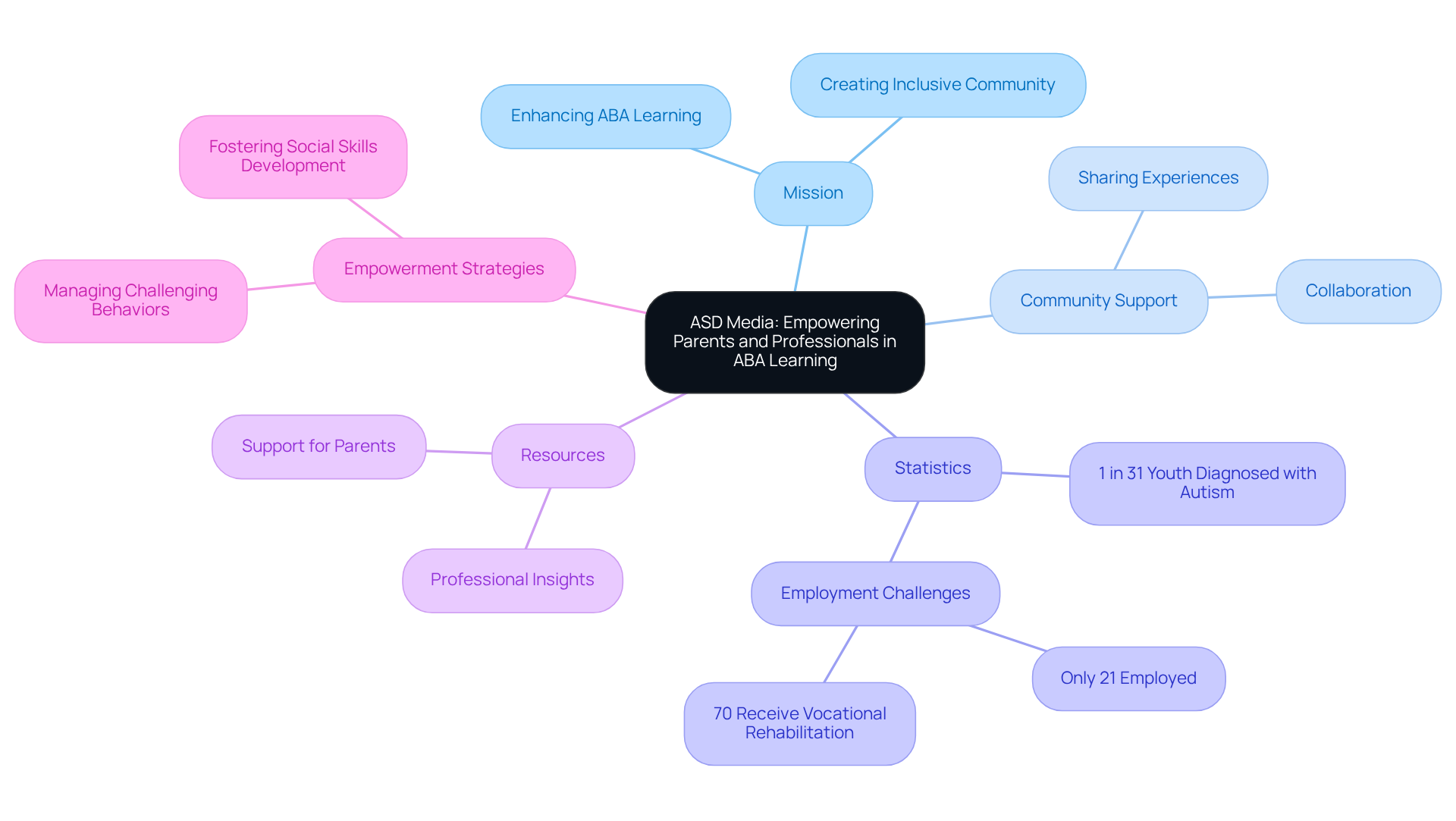
Utilize Positive Reinforcement: Enhance Learning Through Reward Systems
Positive reinforcement is a vital approach in ABA learning, where rewards are provided after desired behaviors to encourage their recurrence. This can take many forms, such as verbal praise, tokens, or tangible rewards. For instance, imagine a young person receiving a sticker for completing a task, which they can later trade for a more significant reward. This not only promotes motivation but also fosters involvement in educational activities.
Research shows that consistently applying positive reinforcement strategies can lead to remarkable improvements in various skill areas:
- Communication skills can enhance by 75%
- Social interactions by 80%
- Daily living skills by 70%
These strategies directly contribute to such growth. Moreover, these methods not only enhance learning outcomes but also significantly boost self-esteem and confidence in young individuals. Creating a motivating environment through effective reward systems, tailored to individual preferences, is essential for encouraging desired behaviors and facilitating long-term success in ABA learning therapy.
Additionally, we encourage parents to actively participate in recognizing and rewarding positive behaviors at home, reinforcing the skills their children learn during therapy. Together, we can create a supportive atmosphere that nurtures growth and success.
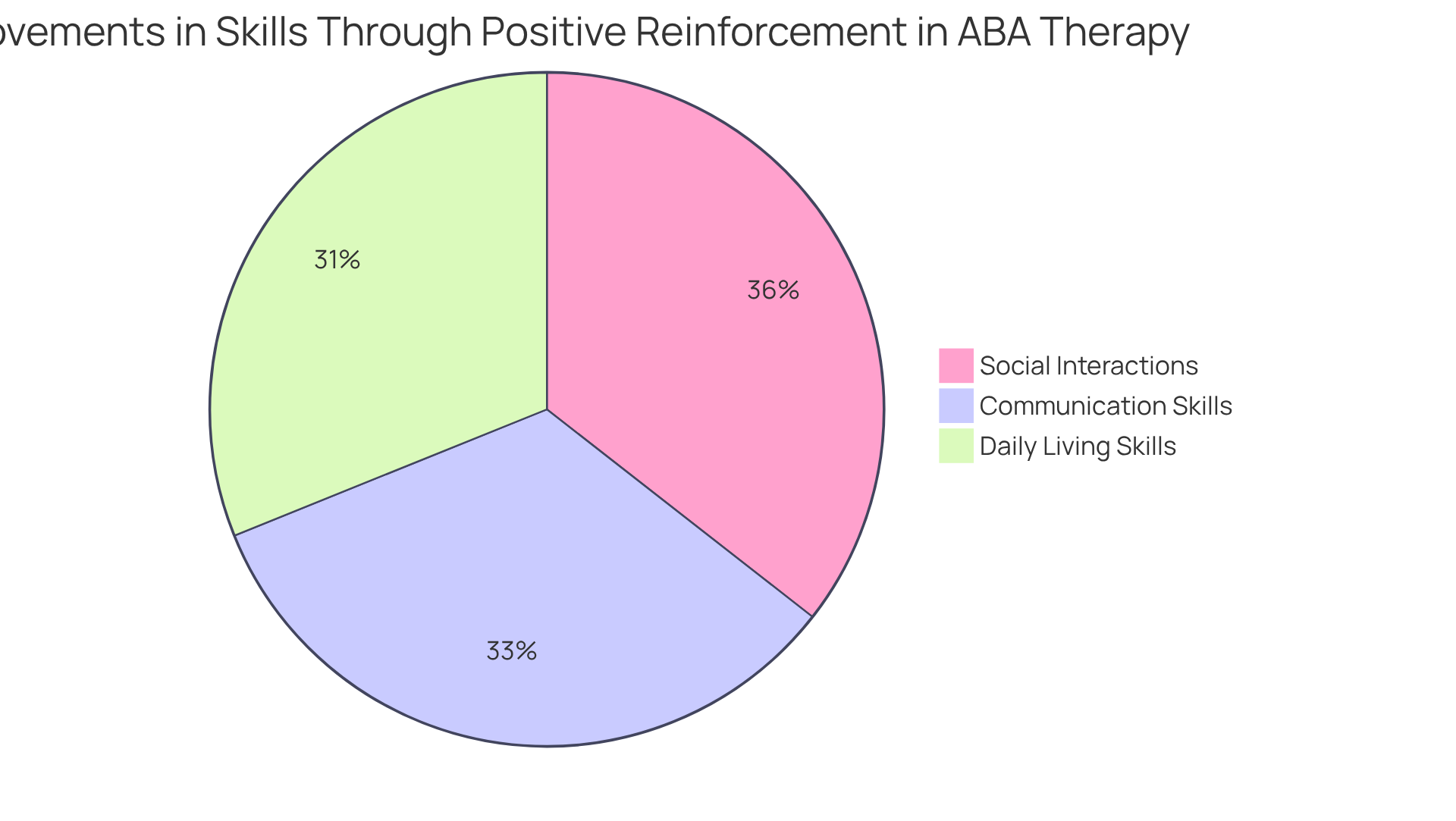
Implement Task Analysis: Simplify Learning by Breaking Down Complex Skills
Task analysis is an essential technique in ABA learning that simplifies complex skills by breaking them down into smaller, manageable steps. This compassionate approach allows young learners to grasp each element in order, fostering a clearer understanding of the entire task. For example, when guiding a young person to wash their hands, the procedure can be divided into specific steps:
- Turning on the faucet
- Applying soap
- Scrubbing hands
- Rinsing
- Drying
By concentrating on one step at a time, young learners not only achieve mastery but also build confidence in their abilities.
Recent studies reveal that this structured method significantly enhances skill acquisition, with 70-90% of individuals with autism demonstrating marked improvement when tasks are effectively broken down. Practitioners emphasize that this approach not only supports learning but also nurtures independence, empowering young individuals to complete tasks on their own.
As highlighted by Nexo ABA Therapy, "If you or a loved one are contemplating ABA therapy, it is essential to collaborate with skilled professionals who utilize data-informed approaches and evidence-based interventions." Incorporating task analysis into daily activities can lead to positive outcomes, making it a vital strategy for parents and professionals supporting individuals on the autism spectrum.
Moreover, hybrid ABA approaches that blend traditional methods with complementary techniques can further enhance the effectiveness of task analysis, providing greater convenience for families. Together, these strategies create a nurturing environment where young learners can thrive.
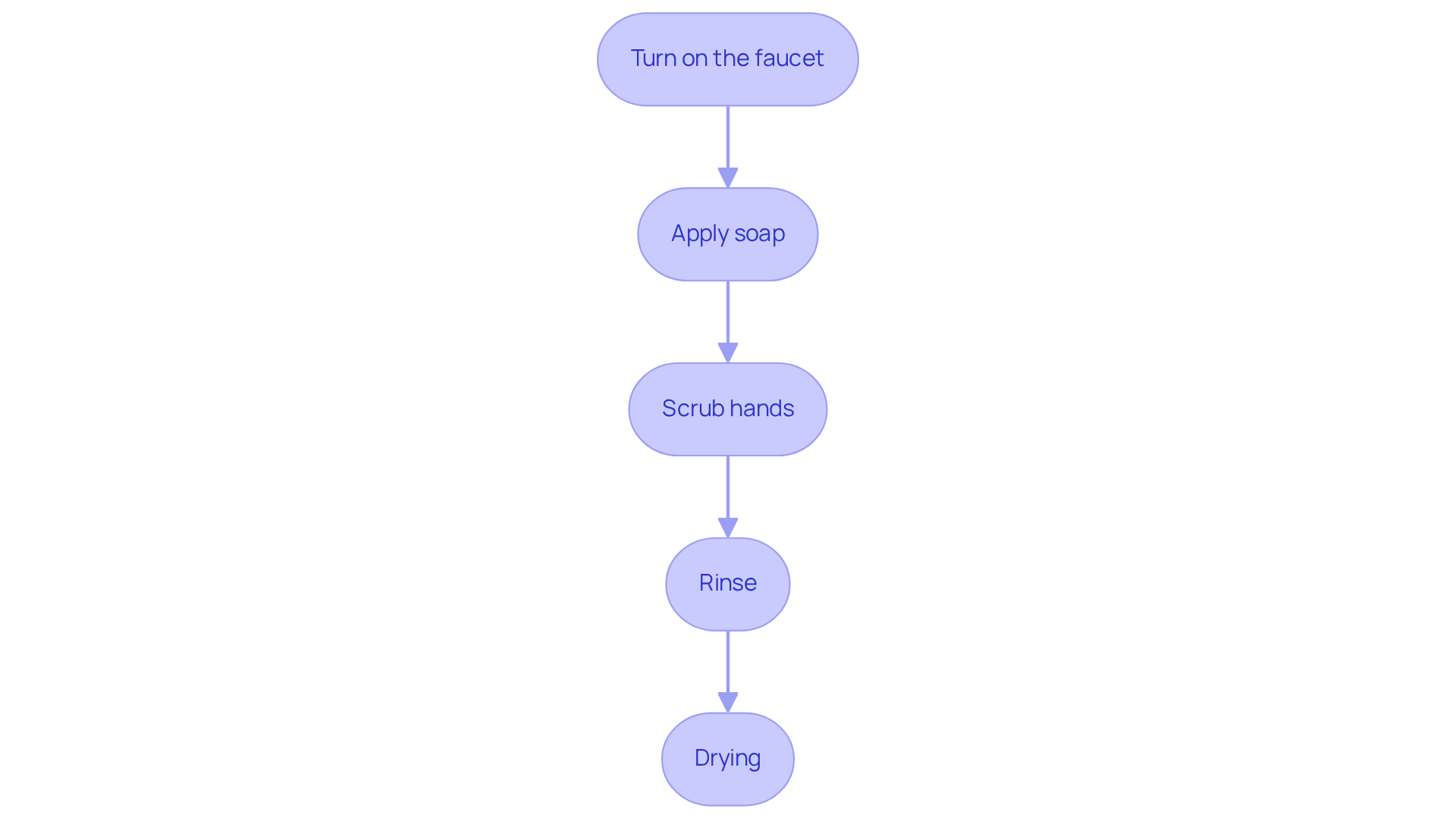
Collect Data Regularly: Monitor Progress to Adjust Strategies Effectively
Consistently gathering information is essential for tracking a young person's development and the effectiveness of the plans in place. This practice can encompass monitoring behaviors, skill acquisition, and responses to various interventions. By examining this information, caregivers and professionals can identify patterns, make informed decisions, and adjust their strategies as needed.
For instance, if a young learner isn't responding to a specific reinforcement strategy, collecting data can illuminate this challenge and encourage a necessary change in approach. It's important to remember that each child's journey is unique, and your observations can make a significant difference.
Consider keeping a detailed record of behaviors and responses; it can be a powerful tool in supporting your child's growth.
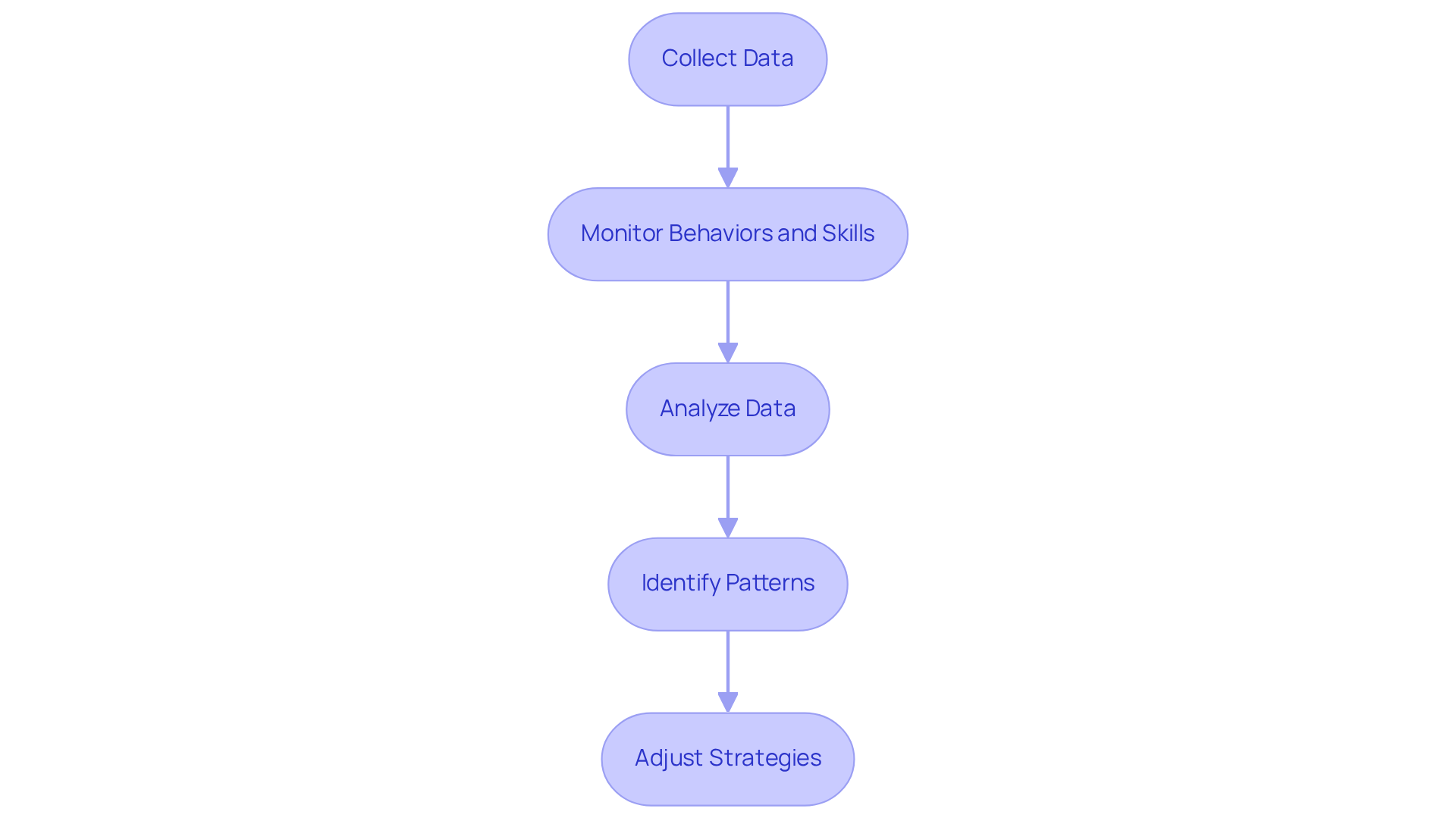
Develop Individualized Learning Plans: Customize Approaches for Each Learner
Creating personalized educational strategies, known as Individual Learning Plans (ILPs), is essential for meeting the unique needs of every student. These plans should consider each child's strengths, challenges, interests, and learning styles. By customizing approaches, caregivers can ensure that interventions are both relevant and effective. For instance, if a young learner thrives with visual aids, integrating more visual supports into their ILP can significantly enhance their learning experience and outcomes.
Research indicates that ABA learning has an impressive success rate of over 89% in treating individuals with ASD, highlighting the effectiveness of personalized strategies. Moreover, family involvement plays a crucial role in achieving positive therapy results, as it supports the young person's development and strengthens family relationships. Caregivers are encouraged to explore various methodologies, such as:
- Discrete Trial Training (DTT)
- Natural Environment Teaching (NET)
to provide a wider array of customization options.
Consistently evaluating and adjusting ILPs based on the child's progress can further enrich their educational journey. Remember, every child is unique, and with the right support and resources, we can help them thrive. What strategies have you found effective for your child? Share your experiences in the comments below; your insights could make a difference for others.
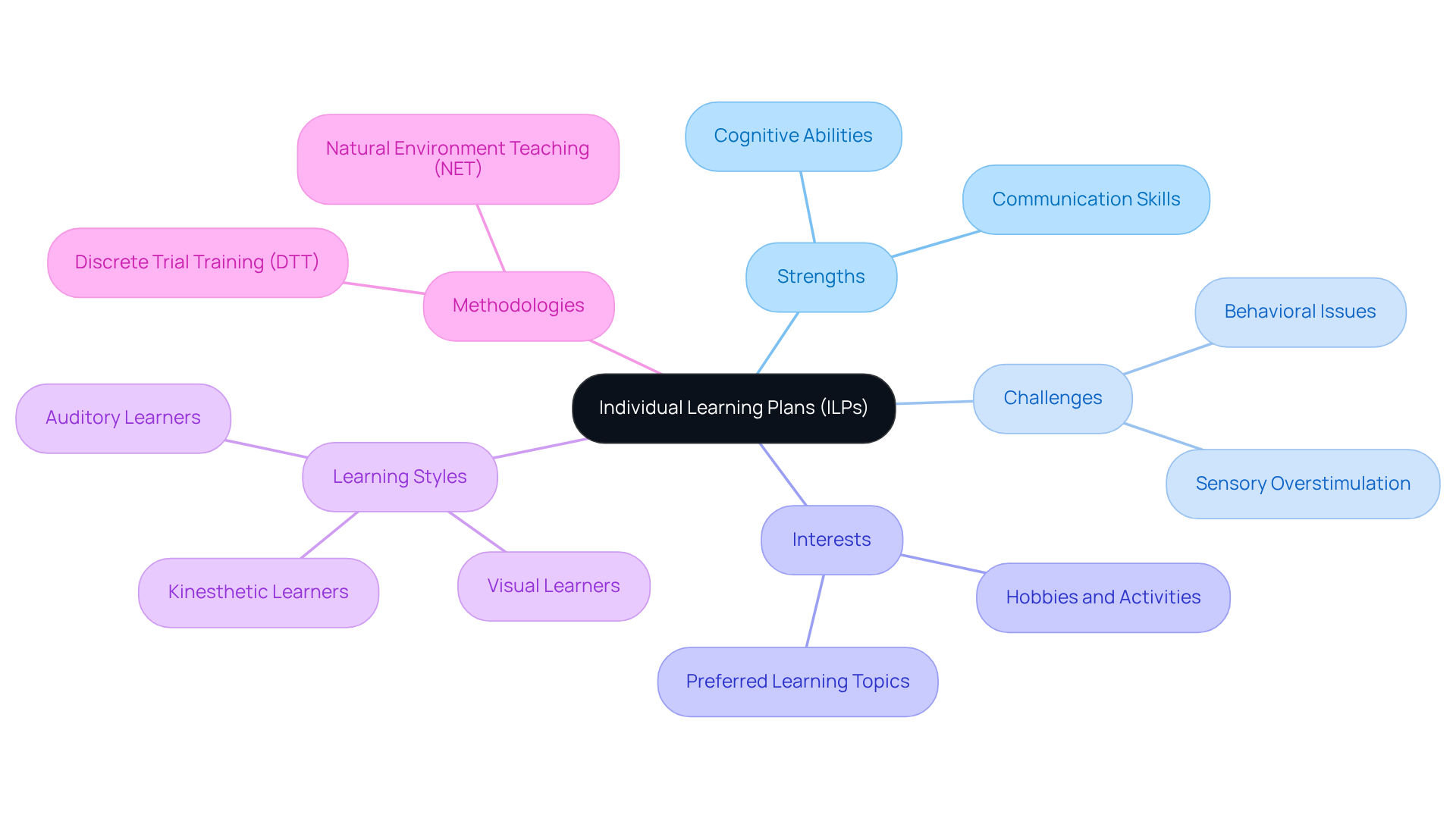
Foster Collaboration: Engage Caregivers and Educators in the Learning Process
Encouraging cooperation between caregivers and educators is essential for creating a nurturing environment in ABA learning therapy. When caregivers and educators communicate regularly and share goals, they enhance the consistency of strategies used across various settings, such as in ABA learning. For example, if a child is learning polite language at home, caregivers and educators can work together to reinforce this behavior in both environments. This unified approach helps children generalize skills and behaviors, leading to a more effective ABA learning experience.
Research highlights that active involvement from caregivers significantly improves youth social behaviors and overall skill acquisition in ABA learning. Dr. Nissa Van Etten notes, "Through collaboration with caregivers, behavior analysts can identify which skills would have social significance to the learner." By joining forces, families and educators can create tailored treatment plans that incorporate ABA learning to address each child's unique needs, ultimately enhancing educational outcomes and fostering independence.
Moreover, regular meetings with Behavior Analysts (BCBAs) are crucial for ensuring effective communication and aligning therapy goals with caregiver observations. This ongoing dialogue further supports the collaborative effort, making it easier for everyone involved to contribute to the child's success. Together, we can make a meaningful difference in the lives of our children.
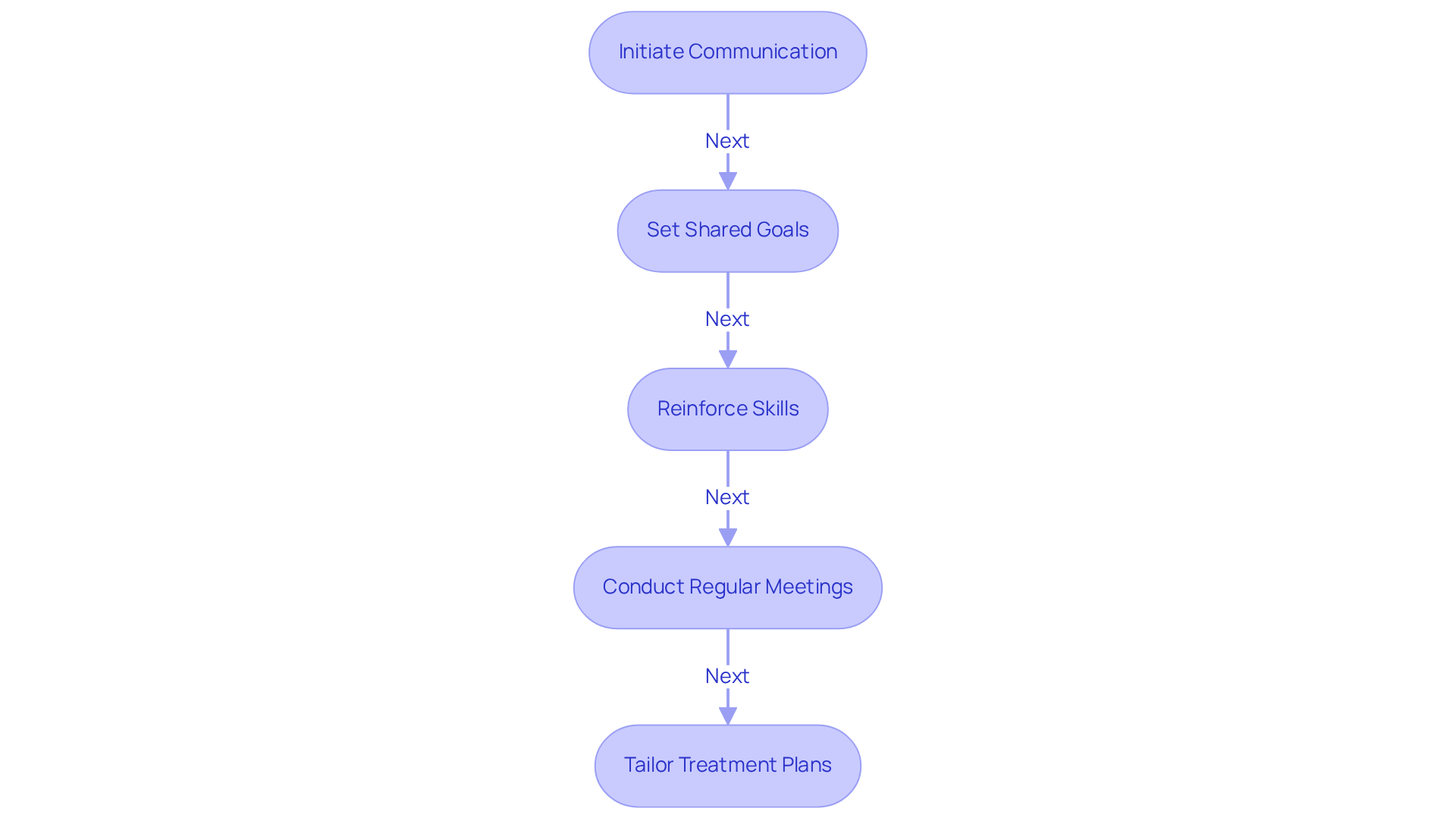
Establish a Structured Environment: Create Predictability for Better Learning Outcomes
Creating an organized setting through ABA learning is crucial for individuals with autism and ADHD, as it provides predictability and alleviates anxiety. By establishing consistent routines, clear expectations, and organized spaces, we can support ABA learning and make a meaningful difference.
For instance, an ABA learning visual timetable can help children understand what to expect throughout the day, allowing them to focus on learning rather than worrying about transitions. An organized environment fosters a sense of safety, which is vital for effective ABA learning.
As Maureen Bennie, founder of the Autism Awareness Centre, beautifully articulates, "Education brings positive change to the lives of those affected by autism and autism spectrum disorders." This statement underscores the transformative power of structured ABA learning environments.
Moreover, statistics reveal that approximately 3.2% of children aged 8 years have been diagnosed with autism, highlighting the urgent need for effective strategies like visual aids. The case study titled 'Creating Structured Environments' illustrates how organized settings support children with autism, reinforcing the effectiveness of ABA learning approaches.
Together, we can create supportive spaces that nurture ABA learning and growth.

Pursue Continuous Training: Enhance Skills and Knowledge in ABA Practices
Continuous training is essential for caregivers and professionals involved in ABA learning therapy. It encompasses workshops, webinars, and conferences, alongside self-study through books and online resources. Staying informed about the latest studies and optimal methods not only enhances personal abilities but also significantly improves the quality of assistance provided to young ones. For instance, mastering new reinforcement techniques can lead to more effective strategies in both classroom and home settings.
Current trends reveal a growing availability of hybrid training models that blend traditional methods with innovative approaches, making professional development more accessible. Engaging in these educational opportunities nurtures a culture of growth through ABA learning, enabling professionals to adapt to changing practices and better meet the needs of the youth they support. As Gallup states, "Training is key for personal and company success," and an impressive 94% of workers prefer to stay with companies that invest in their development.
Moreover, ongoing education not only enhances mental well-being but also minimizes burnout among staff, which is crucial for fostering a nurturing atmosphere for both caregivers and the individuals they assist. By prioritizing continuous training in ABA learning, we can ensure that everyone involved is equipped to provide the best possible support.
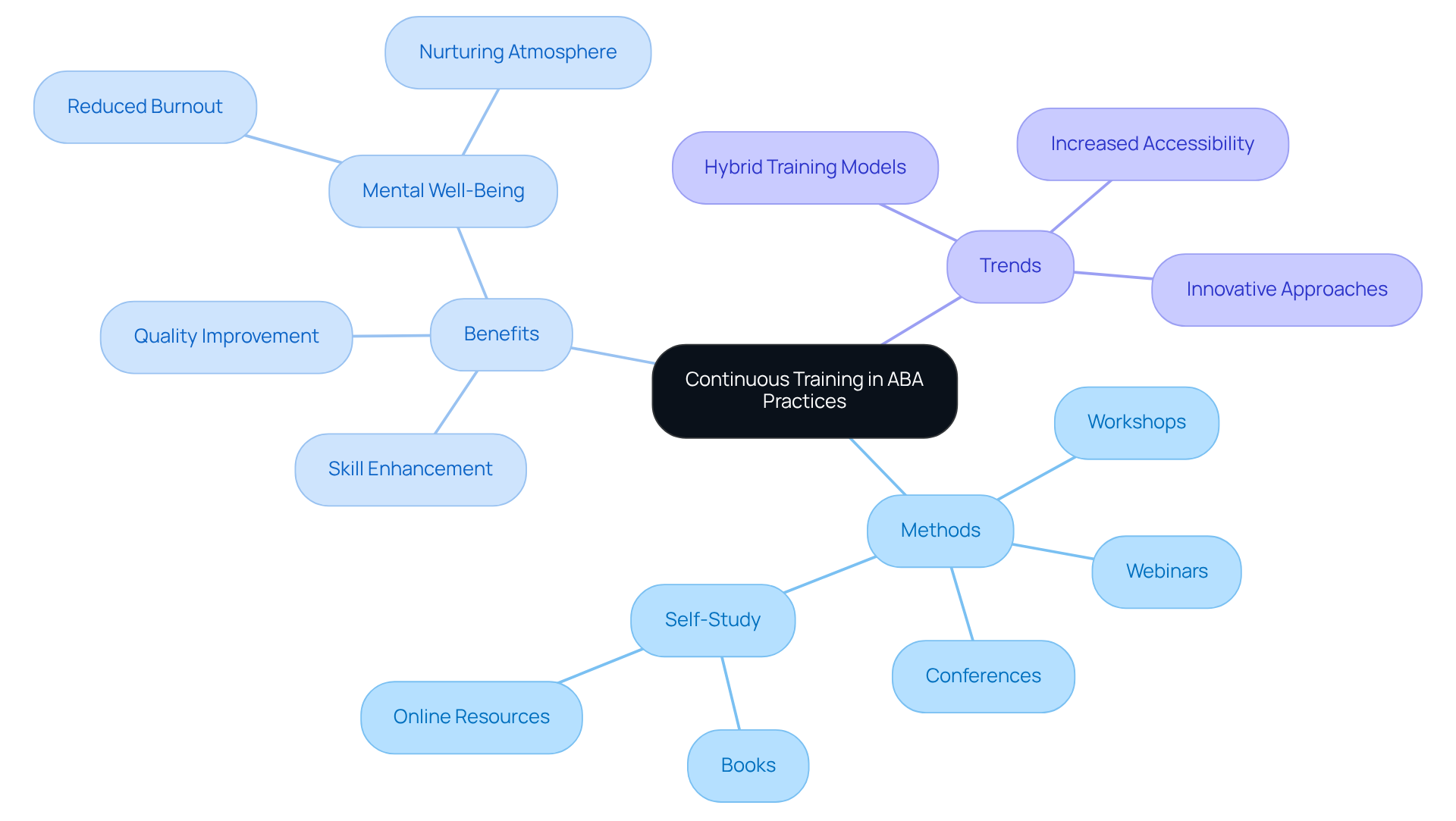
Incorporate Visual Supports: Aid Understanding and Retention in Learning
Incorporating visual aids—such as charts, pictures, and diagrams—can significantly enhance young learners' comprehension and memory. These tools clarify instructions and concepts, making them more accessible.
For example, visual schedules allow children to anticipate transitions and understand daily routines, promoting predictability and responsibility. Research indicates that visual instruction techniques are 83% more effective than text alone, leading to improvements in educational outcomes by as much as 400%.
Educators highlight that visual supports not only facilitate communication but also bolster executive functioning and engagement. By providing clear visual signals, caregivers can reduce frustration and foster successful educational experiences, ultimately enhancing social skills and overall well-being for individuals with autism.
It's crucial to embrace these strategies to support our children in their learning journeys.
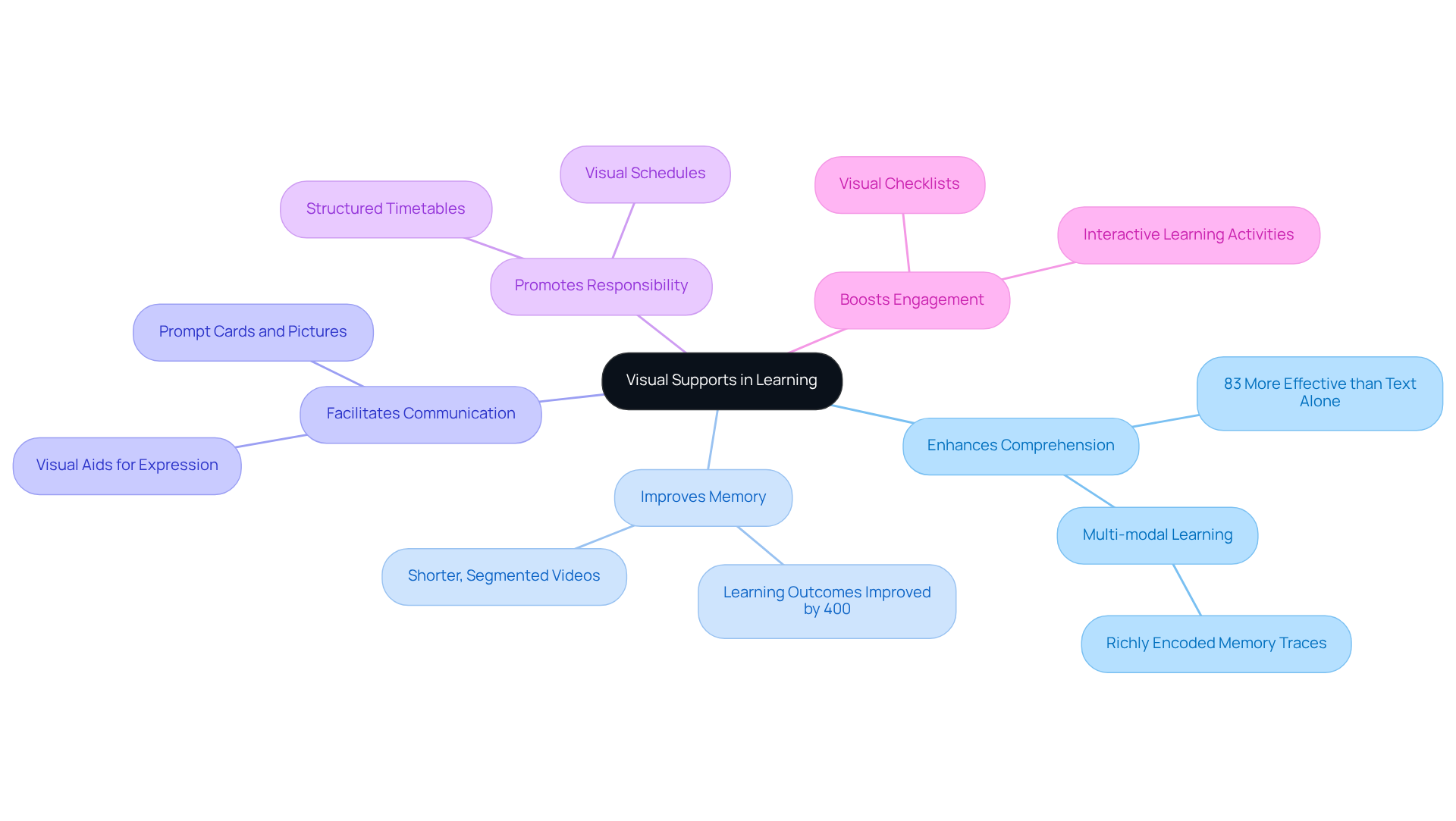
Conduct Regular Assessments: Ensure Strategies Align with Learning Goals
Regular evaluations are crucial in ensuring that ABA strategies truly align with your child's educational goals. These assessments can take many forms, such as:
- Formal evaluations
- Observational assessments
- Progress monitoring
By consistently reviewing your child's progress, you and the professionals involved can pinpoint both successes and areas that may need adjustment. This ongoing evaluation process not only keeps interventions relevant and effective but also plays a vital role in supporting your child's growth and development. Remember, your involvement is key—stay engaged and proactive in this journey.
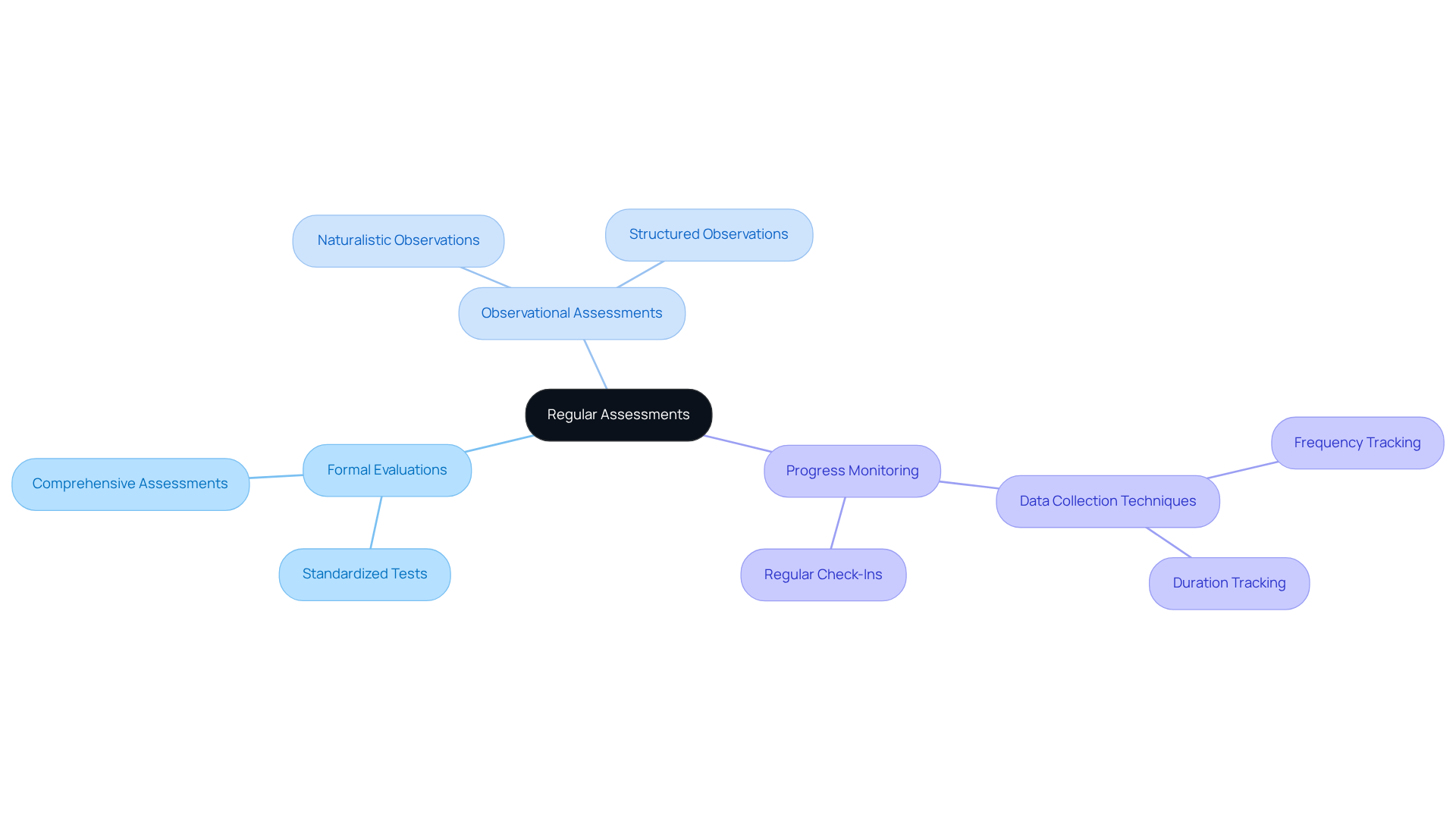
Conclusion
Incorporating effective ABA learning strategies is essential for unlocking the potential of children with autism and ADHD. This article has explored ten impactful methods, highlighting the importance of tailored approaches that cater to individual needs. By fostering positive reinforcement, implementing task analysis, and developing individualized learning plans, caregivers and educators can cultivate a supportive environment that nurtures growth and skill acquisition.
Key insights from this discussion emphasize the necessity of collaboration between caregivers and professionals, the significance of structured environments, and the role of continuous training in enhancing ABA practices. Each strategy is vital in ensuring that children not only learn effectively but also thrive socially and emotionally. By actively engaging in these practices, families can significantly improve educational outcomes for their children.
Ultimately, the journey of supporting children with ASD is a collective effort that requires commitment, understanding, and adaptability. Embracing these strategies empowers children and enriches the lives of families and professionals alike. It is imperative to remain proactive, share experiences, and seek out resources that foster a nurturing atmosphere, paving the way for a brighter future for all involved.
Frequently Asked Questions
What is ASD Media and its mission?
ASD Media is dedicated to enhancing ABA learning by providing valuable insights and effective methods to improve outcomes for individuals with autism. Their mission is to create a nurturing and inclusive community for parents and professionals to share experiences and receive support.
Why is there a need for resources like ASD Media?
The demand for reliable resources has increased due to the CDC report indicating that 1 in 31 youths in the U.S. is diagnosed with autism. Additionally, only 21% of individuals with disabilities, including autism, are employed, highlighting the need for effective support and resources.
What resources does ASD Media offer?
ASD Media offers a variety of support and resources for parents and professionals, including newsletters with the latest news and unlimited digital access to comprehensive resources aimed at empowering individuals with autism and ADHD.
How does positive reinforcement work in ABA learning?
Positive reinforcement involves providing rewards after desired behaviors to encourage their recurrence. Rewards can be verbal praise, tokens, or tangible items, which promote motivation and involvement in educational activities.
What are the benefits of using positive reinforcement in ABA learning?
Research shows that positive reinforcement can lead to significant improvements in communication skills (75%), social interactions (80%), and daily living skills (70%), while also boosting self-esteem and confidence in young individuals.
What is task analysis and how is it used in ABA learning?
Task analysis is a technique that simplifies complex skills by breaking them down into smaller, manageable steps. This method helps young learners understand each part of a task, fostering mastery and confidence.
What are the outcomes of using task analysis in teaching?
Studies indicate that 70-90% of individuals with autism show marked improvement when tasks are effectively broken down, leading to enhanced skill acquisition and increased independence.
How can parents reinforce positive behaviors at home?
Parents are encouraged to actively recognize and reward positive behaviors at home, which reinforces the skills their children learn during therapy and creates a supportive atmosphere for growth and success.
What is the significance of hybrid ABA approaches?
Hybrid ABA approaches combine traditional methods with complementary techniques, enhancing the effectiveness of task analysis and providing greater convenience for families supporting individuals on the autism spectrum.




